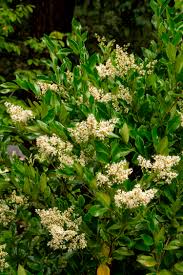Privet
April 29, 2017
![]() Can you help us identify this shrub? I wish I could capture the wonderful aroma of
this tree and send it to you via email or over the phone
Can you help us identify this shrub? I wish I could capture the wonderful aroma of
this tree and send it to you via email or over the phone

![]()
The plant in question is a wax leaf ligustrum. It is a better-behaved relative of the common privet. Both shrubs are blooming now and some like the sweet fragrance, while others think it is too cloying. In my travels around the state the aromas of both the privet and Japanese honeysuckle, which is also blooming now makes for a fragrant ride, although it is messing with my allergies. Wax leaf ligustrum does not reseed like the common privet or Japanese honeysuckle.
![]() There are mimosa and privet trees coming up all over my yard, in the flower beds!
I've been trying to get rid of them for several years now, to no avail. I cut them
down, and they just grow right back, bigger and with more trunks than before. Is there
something I can paint on the stumps that will kill them? Or is there some other way
to get rid of them once and for all?
There are mimosa and privet trees coming up all over my yard, in the flower beds!
I've been trying to get rid of them for several years now, to no avail. I cut them
down, and they just grow right back, bigger and with more trunks than before. Is there
something I can paint on the stumps that will kill them? Or is there some other way
to get rid of them once and for all?
![]() Have you considered moving?! While that may be easier, with perseverance and patience
you can take control, but it takes time. If there is any way to dig out the roots
that will help, but they will still send up sprouts. Chances are also good that there
is privet in other areas in your community which flower and then set seeds, which
the birds eat and drop, resulting in more privet. Pruning, weed-eating any plants
you see, treating the cut area with Round-up or Brush-b-gone (be sure to read label
directions and ONLY apply where you don’t have desirable plants that could be damaged)
can all help. Late summer through fall is a better time to kill woody perennials,
because they tend to be storing reserves for the winter, and will move the chemicals
downward better then too. But total kill is rarely attained in one season. Good
luck!
Have you considered moving?! While that may be easier, with perseverance and patience
you can take control, but it takes time. If there is any way to dig out the roots
that will help, but they will still send up sprouts. Chances are also good that there
is privet in other areas in your community which flower and then set seeds, which
the birds eat and drop, resulting in more privet. Pruning, weed-eating any plants
you see, treating the cut area with Round-up or Brush-b-gone (be sure to read label
directions and ONLY apply where you don’t have desirable plants that could be damaged)
can all help. Late summer through fall is a better time to kill woody perennials,
because they tend to be storing reserves for the winter, and will move the chemicals
downward better then too. But total kill is rarely attained in one season. Good
luck!
All links to external sites open in a new window. You may return to the University of Arkansas System Division of Agriculture web site by closing this window when you are finished. We do not guarantee the accuracy of the information, or the accessibility for people with disabilities listed at any external site.
Links to commercial sites are provided for information and convenience only. Inclusion of sites does not imply University of Arkansas System Division of Agriculture's approval of their product or service to the exclusion of others that may be similar, nor does it guarantee or warrant the standard of the products or service offered.
The mention of any commercial product in this web site does not imply its endorsement by the University of Arkansas System Division of Agriculture over other products not named, nor does the omission imply that they are not satisfactory.